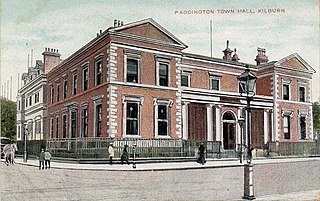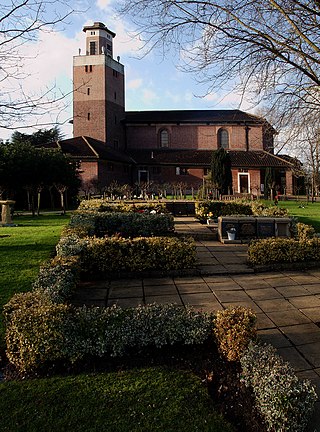
The City of Westminster is a London borough with city status in Greater London, England. It is the site of the United Kingdom's Houses of Parliament and much of the British government. It contains a large part of central London, including most of the West End, such as the major shopping areas around Oxford Street, Regent Street, Piccadilly and Bond Street, and the entertainment district of Soho. Many London landmarks are within the borough, including Buckingham Palace, Westminster Abbey, Whitehall, Westminster Cathedral, 10 Downing Street, and Trafalgar Square.

Regent's Park is one of the Royal Parks of London. It occupies 410 acres (170 ha) in north-west Inner London, administratively split between the City of Westminster and the Borough of Camden. In addition to its large central parkland and ornamental lake, it contains various structures and organizations both public and private, generally on its periphery, including Regent's University and London Zoo.

Paddington was a civil parish and metropolitan borough in London, England. It was an ancient parish in the county of Middlesex, governed by an administrative vestry. The parish was included in the area of responsibility of the Metropolitan Board of Works in 1855 and became part of the County of London in 1889. The parish of Paddington became a metropolitan borough in 1900, following the London Government Act 1899, with the parish vestry replaced by a borough council. In 1965 the borough was abolished and its former area became part of the City of Westminster in Greater London.

The Metropolitan Borough of St Marylebone was a metropolitan borough of the County of London from 1900 to 1965. It was based directly on the previously existing civil parish of St Marylebone, Middlesex, which was incorporated into the Metropolitan Board of Works area in 1855, retaining a parish vestry, and then became part of the County of London in 1889.

Westminster City Council is the local authority for the City of Westminster in Greater London, England. It is a London borough council, one of 32 in London. The council has been under Labour majority control since 2022. Full council meetings are generally held at Westminster Council House, also known as Marylebone Town Hall, and the council has its main offices at Westminster City Hall on Victoria Street.

Cities of London and Westminster is a constituency returning a single Member of Parliament (MP) to the House of Commons in the United Kingdom Parliament. As with all constituencies, the election is decided using the first past the post system of election. Until the 2024 general election, where the constituency elected a Labour Co-op MP, the constituency had always elected the candidate nominated by the Conservative Party.

Queen's Park is an area and partial civil parish in North West and West London, located mostly in the London Borough of Brent, and partially in the London Borough of the City of Westminster. Some of the area within Westminster forms a civil parish, the first to be created in London since the right of communities to establish civil parishes was enacted in 2007. The area is located 4 miles (6.4 km) north-west of Charing Cross, and centred around a 30 acres (12 ha) park, which opened in 1887 and was named in honour of Queen Victoria. The area gives its name to Queens Park Rangers football club.

The London Government Act 1899 was an act of the Parliament of the United Kingdom that reformed the administration of the capital. The act divided the County of London into 28 metropolitan boroughs, replacing the 42 local authorities administering the area. The legislation also transferred a few powers from the London County Council to the boroughs, and removed a number of boundary anomalies. The first elections to the new boroughs were held on 1 November 1900.
Paddington was a parliamentary constituency centred on the Paddington district of London. It returned one Member of Parliament (MP) to the House of Commons of the Parliament of the United Kingdom. The constituency was created for the February 1974 general election, partially replacing the previous Paddington North and Paddington South constituencies, and abolished for the 1983 general election. A Paddington borough constituency has three times been recommended during early stages of Boundary Commission inquiries, only to be altered before the final report was issued.
Boards of improvement commissioners were ad hoc urban local government boards created during the 18th and 19th centuries in the United Kingdom of Great Britain and Ireland and its predecessors the Kingdom of Great Britain and the Kingdom of Ireland. Around 300 boards were created, each by a local act of Parliament, typically termed an Improvement Act. The powers of the boards varied according to the acts which created them. They often included street paving, cleansing, lighting, providing watchmen or dealing with various public nuisances. Those with restricted powers might be called lighting commissioners, paving commissioners, police commissioners, etc.

East Finchley Cemetery is a cemetery and crematorium in East End Road, East Finchley. Although it is in the London Borough of Barnet, it is owned and managed by the City of Westminster.

Marylebone is an area in London, England and is located in the City of Westminster. It is in Central London and part of the West End. Oxford Street forms its southern boundary.

Bolsover Street is in the Parish of St Marylebone in London's West End. In administrative terms it lies within the City of Westminster's West End Ward and is partly in the Harley Street Conservation Area whilst also sitting on the edges of the Regents Park and East Marylebone Conservation Areas.

The Commissioners of Scotland Yard was the informal name for the Commissioners for the Streets and Wayes, a body of improvement commissioners established in 1662 to manage and regulate various areas relating to streets and traffic in the cities of London and Westminster and the borough of Southwark. They were appointed under a 1662 act of the Parliament of England, London and Westminster Streets Act 1662 which expired in 1679. The commissioners' office was attached to that of the Surveyor of the King's Works in Scotland Yard.
Rates are a tax on property in the United Kingdom used to fund local government. Business rates are collected throughout the United Kingdom. Domestic rates are collected in Northern Ireland and were collected in England and Wales before 1990 and in Scotland before 1989.
The following outline is provided as an overview of and topical guide to the city known as London:

The Streets (London) Act 1766 was a public act of the Parliament of Great Britain extended previous road repair and maintenance acts, including the Kensington, Chelsea and Fulham Roads (Tolls) Act 1725 and Kensington, Chelsea and Fulham Roads Act 1740, to cover the roads Clarges Street to Hyde Park Corner and from Park Lane to Hertford Street, under the management of the Commissioners responsible for paving, cleaning, and lighting Westminster.














